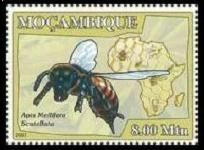 How dangerous are African honey bees (Aphis mellifera scutellata)?
How dangerous are African honey bees (Aphis mellifera scutellata)?
Apis mellifera scutellata is known more commonly as the Africanized honeybee, African honey bee, or killer bee.
Recently a pet professional asked me if I had any thoughts about an incident that occurred where a dog died as the result of dog an African honey bee (AHB) attack. She was a bit alarmed by it but the reality is that although the AHB is more aggressive than other species of bees, the venom they emit is not any more potent than other honey bees–it is the behavior differences that makes them more dangerous.
The problem is that once the AHBs sting, the pheromones they release triggers more aggressive responses from other bees in the colony. So more join in to defend the nest and will attack and continue to pursue a threat for an estimated 1/4 mile.
In general 5-10 stings (from any bee) per pound of body weight can result in a severe allergic reaction. The good news is that infection from a sting is actually more common than envenomation. Some symptoms of reaction include swelling, breathing issues, dizziness, hives, fainting, nausea, vomiting, and pain.
Now when it comes to bee sting statistics, wasps and bees are lumped together so it is hard to get an accurate assessment. However, anywhere from 30-120 deaths are estimated to occur per year in the United States. These are attributed to both toxicity and intense allergic reactions to the stings.
According to government statistics, about 3.3 percent of adults will experience anaphylaxis after an insect sting and there are 40 to as many as 100 deaths annually from insect-sting-related anaphylaxis. Read more here or here.
So far I only found one reference from Brazil related to dog deaths from bee stings by this species and another reference mentioned in passing in a veterinary reference book. But, since pet safety is usually dependent on your safety–I am including information that will benefit you both.
How to Bee Safe?
So how can you remain safe and keep your pets safe against these bees? Paying attention to your surroundings and taking action to refrain from providing a bee friendly environment are good starts.
For instance, removing attraction to a pool or outdoor water source in the yard could be as simple as keeping the pool covered , fixing dripping faucets, or adding a couple of teaspoons of vinegar to the outdoor pet water bowl.
Holes or cracks in walls, trees, or areas in barns and sheds might attract these insects—so fill in those cracks and holes and take steps to make buildings less attractive to insects. Removing junk piles and keeping storage containers closed are other solid practices.
Remember also that outdoor chores could also be hazardous since noise or vibration have been found to spark AHB attacks. The use of a lawn mower, weed eater or tractor has inadvertently resulted in Africanized honeybee attacks. It appears that disturbed insects have been known to react at distances of 150 feet.
Bee Alert?
Additional rainfall has often contributed to increased swarms of bees during the spring and summer but it is the disturbance of the colony or nest that usually brings trouble. If you hear the humming of bees, it is best to get a professional out for an assessment right away.
Often you can identify if there are bee colonies in the area by asking neighbors and checking with the local fire departments as to whether or not they have received reports of any problems. This can help you to avoid any colonies located nearby.
Swarms begin to become visible as the weather warms up and as hives expand and break into smaller groups. Some African honeybees are estimated to move every six weeks or so. The good news is that the AHB normally will attack only if their colony/nest is disturbed and not usually when they swarm.
In general, bees often display defensive behavior before going into a full attack. This includes buzzing around your face or head. These warning signs should be taken seriously and you should vacate the area immediately.
Bee Wise!
What else can you do? Watch what you wear—light-colored clothing is a good choice since bees tend to attack darker colors. Avoid wearing bright colored items or florals since they might attract these stinging insects. If you have a dark pet, a light-colored cover or bandanna might be advisable to make as part of a wardrobe staple.
Bees are attracted by color but also by scent. So many professionals also suggest avoiding floral or citrus scented deodorants, aftershave, lotions, or perfumes. Watch out if your pet has recently returned from the groomer sporting a new scent too.
Bee Attack?
Prevention is the best practice since almost all cases of these African insect attacks have been traced back to provocation.
So the main action to take?
RUN, RUN, RUN!
Avoid swatting because it creates more agitation and you don’t want to piss them off any more than they already are!
Getting into a building or taking shelter in a car are the best strategies to get away quickly–get securely indoors if you can.
These pests will mainly attack your face and head. Use protection such as the sting shield or some sort of head cover.
Placing a cover over your pet as you run may or may not be an option–so get your pet out of the area as quickly as possible and keep him or her from snapping at them.
Prevention is essential when out hiking or horseback riding in areas where these insects exist. Bees are less active when it is cold so plan early morning ambles since they might be less risky and always keep your pet close to keep him or her from running through areas where bees might be disturbed. You might also ponder over to how to protect the eyes, muzzle and ears. (I wonder if a calming cap would help.)
If you are in a bad situation, or you see someone else in trouble, call 911 since fire fighters have AFFF (aqueous film forming foam) and using it will stop and kill AHBs.
Other things you should know?
- Don’t jump into water since the bees tend to wait at the surface to sting you when you come up for air.
- Don’t let animals near areas that contain hives or colonies and don’t tie an animal near insect nests.
- Don’t try and remove a colony or hive yourself! Call a pest control company that specializes in bee removal.
If you or your pet are stung, do not pull out stingers. They need to be gently scraped out to avoid expelling more toxins.
A cold ice pack, baking soda paste (left on for 15-20 minutes) or sting swabs might be helpful.
Having Benadryl on hand or a cell phone to call paramedics would be good. (An epi-pen is useful for life threatening allergic reactions but talk to your doctor about its use.)
Be sure to talk to your veterinarian about the best options for your pet for any venomous insect bites.
Do you have any tips or hints on this topic? If so, leave a comment or chime in over in my Facebook community.
Additional Resources Related to African Honey Bees


